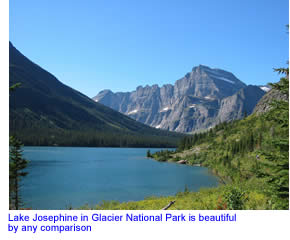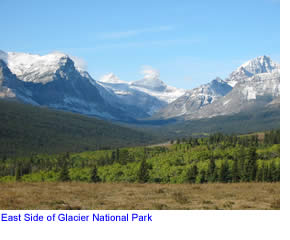
Glacier National Park
Hiking Information

 |
Glacier National Park
|
 |
| Home > Glacier National Park > Hiking Information | Search Site |
Hiking Trails
Glacier National Park
|
Hiking in Glacier National Park
|
 |
| Photo Use Guidelines |
Hiking in Glacier National Park is a very popular activity by visitors. And it's no wonder. Glacier National Park has more than 700 miles of hiking trails, most of which are highly scenic and have incredible views.
The hiking trails in Glacier National Park range in difficulty level. Many trails that lead to scenic vistas are easy hikes and short in length. Other hikes gain significant amounts of vertical and head deep into the backcountry of Glacier Park. Whatever type of hike you are looking for, a trail exists in Glacier National Park to meet your needs.
Before heading out on a hiking trail in Glacier Park, it is important to make sure you're prepared for all contingencies. This section of bigskyfishing.com will go over some of the things any hiker should be prepared for and what they should take when venturing out onto a hiking trail in Glacier National Park.
There are tons of hikes in Glacier, and I've come nowhere close to exploring them all and never will. But I've taken quite a few, so I thought I'd put them up on the site. I've also taken a number of other hikes in GNP (around 10) that aren't listed here. The reason they aren't listed here is because I didn't have a camera at that time.
Also, in addition to the hikes listed under this section,several other hikes are detailed in the Backcountry Fishing section, too (such as the Avalanche Lake Trail, the Hidden Lake Trail and the Logging Lake Trail.)
Weather: The weather in Glacier is highly variable. The continental divide splits Glacier National Park into two very distinct halves. The eastern side of the park, where Two Medicine, St. Mary and Many Glacier are located, tends to be warm and windy in the summer and cold and windy the rest of the year. Since the continental divide takes away much of the moisture, the east side of the park also is significantly drier and sunnier.
By contrast, the western side of the park, where Lake McDonald, West Glacier and Polebridge is located, will be cooler and much less windy during the summer. During the winter, the western side of Glacier National Park will also be warmer than found on the eastern side of the park. The western side of the park receives much more precipitation than the eastern half. As a result, the western side of Glacier is heavily forested. Cloud cover is also much more prevalent, especially between October - June.
Elevation: The western side of Glacier National Park has a lower elevation than the eastern side of the park. Due to the lower elevation, hikes originating on the western side of the park will generally have more of a vertical elevation gain than trails in the eastern side of the park, although trails such as the Avalanche Lake Trail have very gentle vertical gains.
Gear: Any day hiker in Glacier National Park should carry a comfortable day pack that is roomy enough to carry a minimum of two quarts of water, a rain/wind jacket, a fleece/wool jacket or sweater, a first aid kit and some food. Water is everywhere in Glacier National Park. However, some sources of water in Glacier are contaminated with Giardia. Unless you plan on carrying around a water filter (see our recommended list), plan on carrying around enough water for your entire hike. A rain/wind jacket is also needed. Many of the trails in Glacier can be very windy, especially when they near exposed slopes. Even on a warm day you will freeze quickly without some way to cut back the wind. A rain jacket is also needed - the weather is Glacier is just too variable to take chances. Not having a good rain jacket makes for a great way to die from a cold rain in the Glacier backcountry. Food, except for really short hikes, is also something to always have with you as it gives you energy to keep hiking.
 |
| Photo Use Guidelines |
Also, a good pair of hiking boots is absolutely essential. When hiking in Glacier National Park, do NOT wear sneakers, sandals or other shoes that are lacking in any form of ankle support. A hiking boot provides not only much better traction on the rocks; it also provides full ankle support, removing the possibility of a twisted or broken ankle. Unless you want to chance the prospect of limping back to the trailhead over many rough miles, always, always wear good, comfortable hiking boots when hiking in Glacier National Park. You may want to go over the Hiking Boot Guide and see the list of recommended Hiking Boots for Men and Hiking Boots for Women that I've put together, too.
Wildlife: Glacier National Park is a wilderness park, and as such is homes to lots of native and wild fauna. Moose, Elk, Black Bears and Grizzly Bears, not to mention Bighorn Sheep, Mountain Goats and Mule Deer, all call Glacier Park their home. There are no poisonous snakes in Glacier Park, so you don't have to worry about where you step. However, grizzly bears are common in Glacier, so it pays to be knowledgeable about them. Visit our special Grizzly Bear section to learn more on how to avoid encounters with bears altogether and, failing that, on how to survive one.
Know Your Limits: It is important to be honest with yourself before heading out on a trail in Glacier. A trail that has 2000 vertical feet of elevation gain is not an easy trail. It may be nearly impossible for those out of shape or who is not use to hiking. You'll have a much better time hiking in Glacier National Park by sticking to trails that are within your difficulty level. There are many easy, scenic hikes in Glacier Park that are not much more difficult that walking down the block so there is no reason to kill yourself by pushing beyond your physical abilities.
In addition to the trails profiled in this "Hiking Glacier" section, additional hiking trails can also be found in our Backcountry Fishing section, too, where trails like the Snyder Lake Trail and Avalanche Lake Trail are profiled.
Hiking Gear & Equipment Guide for Glacier National Park |
| Hiking Boots : Buyers guide to getting the right boot for hiking |
| Hiking Socks : Guide to getting the right sock for hiking |
| Trekking Poles : Why you should use one when hiking |
| Montana Web Cams | Montana Information | Fly Fishing Gear | Fishing Boats | About | Contact Us | Advertising Information | Privacy Policy |